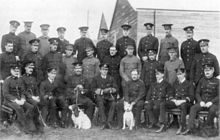Trenchard Lines
Trenchard Lines
|
|||||||||||||||||||
|---|---|---|---|---|---|---|---|---|---|---|---|---|---|---|---|---|---|---|---|

Members and staff on the Central Flying School's first course at Upavon, late 1912
|
|||||||||||||||||||
| Summary | |||||||||||||||||||
| Airport type | Military | ||||||||||||||||||
| Owner | Ministry of Defence | ||||||||||||||||||
| Operator |
Royal Flying Corps 1914-1918 Royal Air Force 1918-1993 British Army 1993 - Present |
||||||||||||||||||
| Location | Wiltshire, England | ||||||||||||||||||
| Elevation AMSL | 574 ft / 175 m | ||||||||||||||||||
| Coordinates | 51°17′26″N 001°46′42″W / 51.29056°N 1.77833°WCoordinates: 51°17′26″N 001°46′42″W / 51.29056°N 1.77833°W | ||||||||||||||||||
| Map | |||||||||||||||||||
| Location in Wiltshire | |||||||||||||||||||
| Runways | |||||||||||||||||||
|
|||||||||||||||||||
Trenchard Lines is a major British Army headquarters. As the former Royal Air Force Station Upavon, more commonly known as RAF Upavon, it was a grass airfield, military flight training school, and administrative headquarters of the Royal Air Force.
The station motto was In Principio Et Semper, and translated from Latin means "In the Beginning and Always". The station crest had a pterodactyl rising from rocks, which symbolised the station's connection with the early days of flying, and was also a reference to the location of the station near to the ancient monument Stonehenge.
Construction began on 19 June 1912, on some training gallops, on an elevated site about 1.5 mi (2.4 km) east of Upavon village, near the edge of the Salisbury Plain, in the English county of Wiltshire. The RAF site is unusual, in that it is bisected by a public highway, the A342 – with the airfield and hangars on the south side of the road, and all the administrative (and some technical) buildings and accommodation on the north side.
Upavon Airfield was originally created for pilots of the military and naval wings of the newly formed Royal Flying Corps (RFC), and became home to the army Central Flying School (CFS). Captain Godfrey M Paine, RN, became the first commandant, with Major Hugh Trenchard being his assistant. Trenchard later became the chief of air staff, and subsequently became known as the "father of the Royal Air Force".
...
Wikipedia

